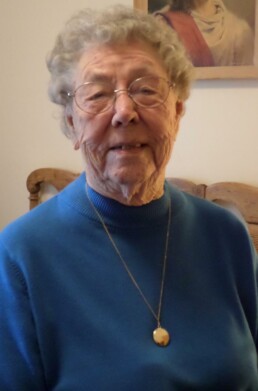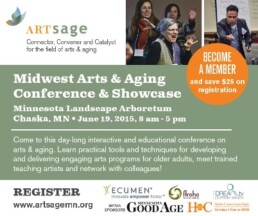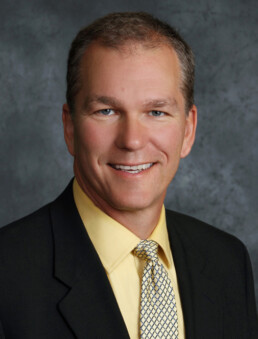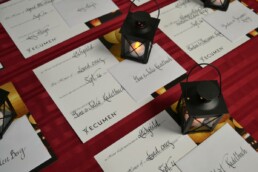Ecumen Blogger Jim Klobuchar: Return to Venice, Return to Youth
Going back to Venice is like going back in time -- to a place where youth is restored.
Ecumen Blogger Jim Klobuchar — Sometimes Big Men Cry
When Fran Tarkenton stood up for Mick Tingelhoff at his NFL Hall of Fame induction, tears were flowing because their friendship was even bigger than the award.
Ecumen Blogger Jim Klobuchar—The Worst Place Ever for a Flat
Just changing a flat tire is bad enough, but what if a lion is watching you do it?
Ecumen Blogger Jim Klobuchar — Lutheran to the Rescue at the Vatican
A Lutheran bishop who knows his stuff saves the day on a tour of the Vatican.
Ecumen Blogger Jim Klobuchar — The Other Side of Nature’s Beauty
The recent earthquake in Nepal reminds Jim Klobuchar of the country's majestic beauty -- and devastating poverty.
The Strangest Bedfellows — By Ecumen Blogger Jim Klobuchar
Bleats of nostalgia broke out with the approaching shutdown of the almost legendary Nye’s Polonaise bar and restaurant in Minneapolis. They have not subsided since the most recent owner delivered the bad news.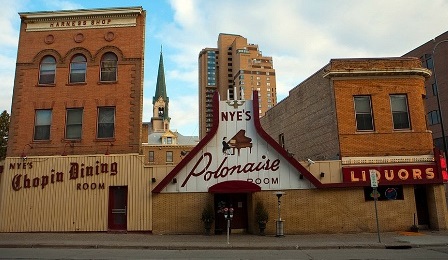
Loyalists remember Al Nye, the proud and hulking owner who popularized it. They remember sing-along sessions around the piano that turned amateur songsters from nearby factories into waiting-to-be-discovered successors to Placido Domingo and Renee Fleming. They remember the cuisine intended to replicate the best of Eastern Europe but was more like the aromas of home kitchens of Northeast Minneapolis, more familiar to the sons and daughters of the immigrant years.
My own regrets have nothing to do with the ambiance of Nye’s Polonaise as much as the inventiveness of its founder, Al Nye, in salvaging a dozen big pay days from the most implausible source, a football clinic that I taught in the early years of the Vikings arrival in Minnesota.
The classes were held every other week. The sponsor was the Minneapolis Star Tribune, for which I covered pro football in the Vikings’ early years. The cost was a few dollars a session. We rotated the classroom site every few years but usually wound up close to the football-loving precincts of Northeast Minneapolis. We didn’t get into the more arcane parts of pro football strategy but, after two weeks or so, it was clear to me that my students could tell the difference between a Red Dog and a Hot Dog.
We usually chose a venue that served lunches and snacks and offered a temperate selection of drinks, so that none of the 150 or so students who attend each session would feel deprived. In other words, it was a payday for the owner.
Nye’s Polonaise was familiar to me by then, partly because it stood virtually next door to the much revered Our Lady of Lourdes Catholic Church, said to be the oldest in the city. The problem with conducting the clinic in Nye’s was the absence of anything close to an auditorium where we could comfortably conduct our course of higher learning.
“You need chairs — more than a hundred,” I told Al. “You need a place to put the scholars.”
“I’ve got a place in the basement,” he said. “It’s clean, comfy and adequate, and will seat them all.”
“What about chairs?
Al Nye considered this newest crisis calmly.
“We’re neighbors,” he said of Our Lady of Lourdes, “historic church, wonderful church.”
“And…” I said, suddenly worried about a clash of cultures.
“They have chairs,” he said, “Hundreds of chairs. Nye’s Polonaise has a basement room. Clean, comfortable and user friendly. I’ll talk to the Fathers. I’m sure we can work out an arrangement. We have an excellent relationship. We’ll send platoons over to pick up the chairs and bring them back.”
Do you have any serious doubt about Al Nye being able to work out an arrangement? All I can tell you is that 150 chairs were there in Al Nye’s basement every Tuesday night. I’m equally sure that they were back in the church the next day.
So I had to call this jerry-built classroom — beneath the sing-alongs at the piano and an occasional broken beer bottle overhead — a rousing success. I even announced Al as our visiting celebrity for one of the evenings.
When he left, I asked my class their impressions.
“Okay,” one of my scholars said. “Al was very good but Bud Grant might have been better.”
I said it was hard to picture Bud Grant diagraming a five man blitz in the middle of a polka party.
TV Through the Looking Glass — By Ecumen Blogger Jim Klobuchar
The recent shuffling among some of television’s most famous anchors reminds us that this unavoidable news and entertainment service sometimes needs serious help.
I have no special wisdom to offer television in its travails, except to say: It might have been worse.
For several years of my newspaper career in Minneapolis, I conducted a weekly public affairs television show and later a talk show on radio and an interview show on public broadcasting.
It was unpredictable and never dull. One year the producer invited Howard Cosell, the learned and unfailingly wordy sports personality, to be my guest. Howard invariably wanted to be sure that if his reputation had not preceded him, he was going the spare the audience that void. He decided to adopt an endearing attitude after my introduction and announced: ‘I’m absolutely thrilled to be back in these delightfully remote hamlets of Minneapolis and St. Paul.”
The years when I was part of the local TV mix were leaner times. Programs were not heavily funded or staffed and didn’t derive the huge advertising revenue they do today, especially the massive bucks that professional sports harvests for them.
It was, by those measurements, literally primitive. The guest on one of my interviews was Vern Gagne, the former professional wrestler and promoter. He happened to be a good friend of mine despite my public suspicions that pro wrestling was a noisily staged production in which the hero, or at least the choice of the promoter, always won.
Gagne bitterly denied this as my TV guest. On camera he gave a demonstration of some of the popular holds in wrestling and puckishly gave me personal demonstration on live camera. One of them, which he called the “sleeper hold,” temporarily left the victim (me) unconscious. On live television.
They woke me up minutes later, just before the producer got through on a 911 call declaring: “Our star interrogator is down from a sleeper hold, and this is no drill.”
But that was well before my public affairs show when the big issue was whether the public should fund what would later become Metropolitan Stadium. The station issued an open invitation for its viewers to join the debate on my show in a public forum in the studio. We had a platform and space to handle the crowd, estimated at 18 or 20 folks, representing public opinion on the issue.
In the early evening of the taping a merciless rainstorm struck, and at the deadline for the taping there were only three people there, plus the technicians and the camera people, and the moderator — me. Hardly enough to call a quorum.
The producer said we couldn’t present three people as a reasonable cross section. “Only one way we can rescue this is to go around town when the downpour eases and find 15 people, at least, to make it creditable,” he said.
We found one or two volunteers among the early arrivals and drew straws to decide who went where to gather our quorum. I drew Augie’s Bar on Hennepin in Minneapolis, which wasn’t that far away. I uncovered at least three or four volunteers, none of whom slurred words, a critical qualification.
Two of the women in the group dragged in volunteers from their sewing clubs.
One way or other, our group filled the allotted space. I called the debate to order, and they argued the question civilly. There were no open bottles, and they ultimately cast their preference.
Naturally, I’m sworn to silence on how the debate was argued. I can only tell you the viewer response was favorable, the stadium was built and Harmon Killebrew is in the Hall of Fame.
Don’t knock old time television.
Top 5 Most-Read Articles - December 1
In case you missed out, here are the articles Ecumen's online visitors found most interesting last week:
Ecumen Century Club: Angeline Lee, 108, and Eunice Anderson, 103
Angeline Lee and Eunice Anderson, who live at Ecumen-managed Clarkfield Care Center, have a Nov. 30 birthday in common and also share extraordinary longevity. This Sunday they will be celebrating their birthdays that add up to 211 years of living. ...
Dementia-Friendly Communities Emerging in Midwest
Around Minnesota and Wisconsin, you will be seeing more businesses posting a new window cling with a purple angel symbol and this message: "We are a Dementia Friendly Business." ...
How to Say Thank You to a Caregiver This Thanksgiving
As if next week's national day of giving thanks weren't enough to express gratitude to those who care for relatives in need, it's also National Family Caregivers Month. ...
The Life-and-Death Experience of Ecumen Board Member Kris Linner
"There is no way to explain that feeling of life leaving," says Rev. Kris Linner, who has spent the last 15 years doing hospice work, ministering to hundreds of people as the spirit leaves the body. How can she do this? It's a probing question she gets all the time, and this is her mystical answer...
Ecumen Blogger Jim Klobuchar: Geese Lover Strikes Out
The season's first snowstorm set off predictable snarls of martyrdom among the early monring dirvers with whom I share the road. ...
You can read these articles and more at www.ecumen.org.
Top Five Blog Posts - September 22
In case you missed out on one of our most popular Changing Aging blog posts, here are the stories Ecumen's online visitors found most interesting last week:
Her Cup Runneth Over: Ecumen Detroit Lakes Chaplain Vicki Marthaler Retires After 19 Years
Media Around Minnesota Discuss Ecumen Scholars Nursing Program
Ecumen Blogger Jim Klobuchar - The Trail Less Traveled
Ecumen Century Club: Happy 101st Birthday, Anna Holst
To read more Changing Aging stories or to learn more about Ecumen, please visit www.ecumen.org
The Unheralded Joy of an MRI - by Ecumen blogger Jim Klobuchar
I lunch occasionally with one of my medical friends, who basically avoids hospital talk. But now and then he brings himself up to date on the status of my joints and miscellaneous body parts.
The last conversation got around to one of the most popular miracles of modern medical science - magnetic resonance imaging. Mercifully called “MRI” in clinical talk. My friend asked if I had tapped into this latest marvel. I said as far as I know I’ve had X-rays galore, but wasn’t sure about MRI. He defined its remarkable gifts, including its ability to create a magnetic field that enables doctors to scan the body’s tissues from the spine to the brain and to discover whether there are any abnormalities.
I’m not going to implicate my friend the doctor in a call I made to a neurologist’s office a few weeks later. My next birthday, in April, will be my 85th. With no intention to create a documentary of my movements the last few years, I will confess that they have included treks in the Himalayas, workouts on the treadmill, tennis matches, a variety of authorships and races with my wife to the TV surfer when we were confronted with colliding tastes.
Still, the advancing calendar being hard to ignore, ultimately I made an appointment with a neurologist, who asked what I had in mind. “Moments of forgetfulness,” I said. “I came home from a meeting the other day and couldn’t find my billfold. I thought it might have dropped from my pocket where I sat; so I drove back to the meeting room, looked around, tried the parking lot, all the rest. Drove home. Turned the house upside down.”
“And?” he asked.
“The billfold was sitting harmlessly on the seat of my chair in front of the computer where it had been all the time, same color as the seat.”
“You could have predicted,” he said. I nodded. But I said I was curious, wanted to maximize my later years if that was possible, and all…
He nodded and scheduled me for an MRI brain scan, which I took a few weeks ago.
I arrived early. 6:30 a.m. They had the necessary documentation. The nurse smiled a greeting, handed me the familiar wrap, cleared me of any metal objects, and said there was going to be a lot of noise inside the tube. She asked, in fact, if I had any serious fear of being confined to tight and noisy places. Having worked for nearly 50 years in a variety of news rooms, I said I could probably deal with it.
So she slid me into the tube, gave me a set of ear phones and asked if I cared to listen to FM radio as a distraction from the noise. I considered this offer but then asked whimsically whether she could upgrade to Mozart instead.
“I have it,” she announced triumphantly.
And so the doors slammed shut, internal noise kicked in and suddenly here was the music of Mozart, and I could scarcely believe what the nurse had dialed in. Beside his operas and symphonies and violin music and a half dozen other forms, Mozart wrote 27 piano concertos. His last – the 27th piano concerto written not long before he died - has been my favorite since I first heard it played by a Japanese woman in concert years ago. The music the nurse had dialed wasn’t the opening but the slow second movement, marked Larghetto by Mozart. A melody neither sad nor gloomy, but tender and wistful and altogether lovely. And one more thing: It’s practically the only Mozart piano concerto that I can play bearing any remote similarity to how it was written.
So I was totally overjoyed and I couldn’t restrain a shout-out to the nurse.
“Can I sing?” I yelled to the nurse.
“No,” she yelled, definitely horrified. “DON’T sing.
In other words, you’ll mess up the magnetos or the pulses or whatever was creating the magnetism flowing through the tube. And now the Mozart had shifted to his violin sonatas. And I had to stop to consider: When I was kid so long ago, what I knew about the equipment available to doctors was pretty much limited to forceps, needles, swabs, scalpels, bed pans, stethoscopes and stomach pumps.
And now, thank God, they were into MRIs, quadruple bi-passes, stents and more. But that wasn’t all. Near the end of the MRI the Mozart disappeared, replaced by a banging and hammering that sounded like a runaway road grader assaulting the walls of my tube. Toss in what sounded like an in-house thunderstorm.
And then silence. The tube door opened to reveal a smiling nurse. She said it was all part of the electronic examination and ultimately the doctors would get a picture.
“But, it’s finished. How’d it go,” she asked.
“Fabulous,” I said. “Thanks for the Mozart and, the rest.”
She led me back to my locker and said I was an excellent patient, but she couldn’t give me a clue.
The results? The neurologist’s office called to schedule a follow up in a few weeks “The preliminaries,” he said, “are not at all bad.”
I told him I handn’t misplaced my billfold in three weeks. He thought that was progress.

